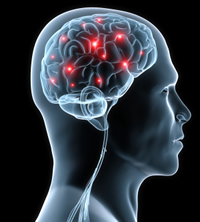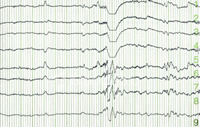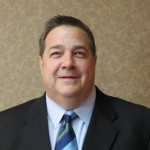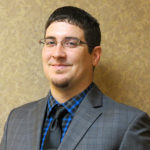Neurotherapy Institute of Central Illinois
(A Division of Chapin & Russell Associates)
EEG Biofeedback for the Brain
Recent advances in brain science, medical electroencephalography (EEG) and computer technology have brought the benefits of neurofeedback out of research laboratories and into practical and effective clinical treatment. Today, clients who have not responded to traditional counseling and medication can expect meaningful improvement in cognitive, emotional, behavioral and physiological functioning with neurotherapy.
 Throughout life our brain is subjected to much distress. Upon conception, we inherit genetic predispositions to certain neurological vulnerabilities. Our mother’s health and emotional stability play a key role in our developing neurological resilience. Stressful environmental factors, early illness and high fever, exposure to toxins, diet high in food additives, sugar and carbohydrates, and excessive stress from work and dysfunctional personal and family relationships can also disregulate brain activity. In more extreme situations, life with emotional trauma, head injury, bouts of chronic disease with pain, prolonged medication use and repeated exposure to anesthesia, can further disregulated neurological functioning. Even the normal process of aging can impair our brain’s healthy self-regulation.
Throughout life our brain is subjected to much distress. Upon conception, we inherit genetic predispositions to certain neurological vulnerabilities. Our mother’s health and emotional stability play a key role in our developing neurological resilience. Stressful environmental factors, early illness and high fever, exposure to toxins, diet high in food additives, sugar and carbohydrates, and excessive stress from work and dysfunctional personal and family relationships can also disregulate brain activity. In more extreme situations, life with emotional trauma, head injury, bouts of chronic disease with pain, prolonged medication use and repeated exposure to anesthesia, can further disregulated neurological functioning. Even the normal process of aging can impair our brain’s healthy self-regulation.
The brain has been called the “Master Organ.” It controls all of our physiological, emotional, and cognitive functioning. One of the primary ways it does this is by regulating the brain’s healthy electrical activity. When it is operating well, we experience health and emotional well-being. When it becomes disregulated, we experience stress and “dis-ease.” In simple terms, the brain begins to use the wrong brainwaves, at the wrong time, for the wrong task. This can take three general forms. When the brain becomes over-activated, it experiences problems like anxiety, anger, OCD, insomnia, and impulsiveness. When it is under-activated, it experiences depression, inattentiveness, difficulty waking, and problems with motivation. When it has unstable-activation, it may experience migraine headaches, panic attacks, seizures, PTSD, bipolar disorder, fibromyalgia, PMS or IBS.
Neurotherapy improves brain disregulation by training the brain to use the right brainwave, at the right time, for the right task. It employs several types of treatment including biofeedback of peripheral skin temperature and heart rate variability for improved physiological self-regulation, audiovisual entrainment that uses light and sound stimulation to elicit the desired brainwave activity, and neurofeedback to teach the brain how to self-regulate its optimal neurological functioning.
 Neurofeedback utilizes an electroencephalograph (EEG) that measures real-time, brain electrical activity and changes it, toward the desired direction, by reinforcing it with enjoyable music or DVD rewards. In order to hear the music or see the video, the brain must either increase or decrease targeted problematic brainwaves. For example, to treat anxiety, clients learn how to reduce high beta waves. To treat depression, clients learn how to activate low beta waves. To treat ADHD, clients learn how to activate their sensory motor rhythm and decrease distracting theta and beta brainwaves. After a sufficient period of training, usually 20 to 40 sessions, healthy brainwaves are strengthened and problematic brainwaves are diminished.
Neurofeedback utilizes an electroencephalograph (EEG) that measures real-time, brain electrical activity and changes it, toward the desired direction, by reinforcing it with enjoyable music or DVD rewards. In order to hear the music or see the video, the brain must either increase or decrease targeted problematic brainwaves. For example, to treat anxiety, clients learn how to reduce high beta waves. To treat depression, clients learn how to activate low beta waves. To treat ADHD, clients learn how to activate their sensory motor rhythm and decrease distracting theta and beta brainwaves. After a sufficient period of training, usually 20 to 40 sessions, healthy brainwaves are strengthened and problematic brainwaves are diminished.
The research on neurofeedback is impressive. Outcome studies have found: 75% reduction in ADHD, a 9 to 23 point improvement in IQ, 80% recovery rate for compulsive behaviors, only a 20% relapse of panic attacks for PTSD, 70% reduction in epileptic seizures, 88% improvement in depression, 80% reduction in hypertension, 50% reduction in migraine headaches, more than 50% improvement in memory, attention and problem-solving in 88% of patients with traumatic brain injury (TBI) and significant improvement in sociability, communication, and sensory awareness in autistic children. Even professional athletes, fortune 500 executives, surgeons, performing artists and college students have reported significant improvement in their personal performance.
Major Advantages of Neurotherapy
- Effective for Cognitive, Emotional, Behavioral and Physiological Problems
- Utilizes Latest EEG, Computer and Behavioral Technology
- Treats the Source of Neurological Dysregulation
- Non-Medication Based Treatment
- Few, if any, Side Effects
- Strong Research Evidence
- Effective for Clinical Problems and Improving Personal Performance
Neurotherapy Training for Burnout
Recent advances in brain science, quantitative electroencephalography (QEEG) and computer technology have demonstrated that much can be done to effectively alter and retrain the underlying neurophysiological dysregulation that accompanies burnout and its debilitating emotional, behavioral, and cognitive consequences. Research on the effects of biofeedback and neurofeedback training on burnout have found significant benefits for sleep, anxiety, stress, trauma, emotional balance, and cognitive functioning. Through the Rejuvenate Program, Chapin & Russell Associates aims to provide clients neurofeedback training for burnout, based on its effectiveness in treating burnout symptoms.
Professional EEG Biofeedback Certified Neurotherapists (Board Certified*)
Neurotherapy is provided by fully trained Neurotherapists who are licensed health care providers and have a master’s or doctorate degree in their professional field. They have completed a minimum of 45 hours training by a nationally recognized neurotherapy training provider and participate in ongoing case consultation with one of the top three neurofeedback trainers in the country. Our trained Neurotherapists provide all of the evaluation, diagnosis, treatment planning and case management services for each neurotherapy client; however, a neurotherapy technician may be utilized at times to conduct repeated training sessions. For more information you can read a copy of the Neurotherapy Informed Consent Form or call for a free telephone consultation.
 Ted Chapin, Ph.D.*
Ted Chapin, Ph.D.*
Licensed Clinical Psychologist
 Brad Post, MSW
Brad Post, MSW
Licensed Clinical Social Worker
Certified Alcohol and Drug Abuse Counselor
 Jason DeFord, M.A.
Jason DeFord, M.A.
Licensed Clinical Professional Counselor
 Shane Young, M.A.
Shane Young, M.A.
Licensed Clinical Professional Counselor
Suggested Reading
- Chapin, T.C. & Russell-Chapin, L.A. (2020) , N.Y. Integrating Neurocounseling in Clinical Supervision – Strategies for Success. Routledge, NY.
- Chapin, T.C. (2017) White Paper: Comparison of Neurofeedback Services at Neurotherapy Institute of Central Illinois vs Brainpaint Offered by Peoria Area Providers
- Amen, D.G. (1998). Change Your Brain Change Your Life. Three Rivers, NY.
- Chapin, T.C. & Russell-Chapin, L. A. (2014). Neurotherapy and Neurofeedback. Routledge, NY.
- Fontani, G.; Corradeschi, F.; Felici, A.; Alfatti, F.; Migliorini, S.; Lodi, L. (2005)
- Cognitive and Physiological Effects of Omega-3 Polyunsaturated Fatty Acid Supplementation in Healthy Subjects. European Journal of Clinical Investigation.
- Robbins, J. (2008). Symphony in the Brain. Grove, NY.
Suggested Videos
- Drs. Ted Chapin and Lori Russell-Chapin | Neurotherapy: Treatment for Psychological and Behavioral Problems
- Mike Cohen | Center for Brain | What Is Neurofeedback? How Brain Training Can Benefit Kids, Families, and Adults.
- Mind Media featuring Nexus | Neurofeedback – New Focus on ADHD
- Daniel Amen | TEDxOrangeCoast | The most important lesson from 83,000 brain scans
- CBS Denver | Former NFL Players Seek Concussion Relief Through Neurofeedback



